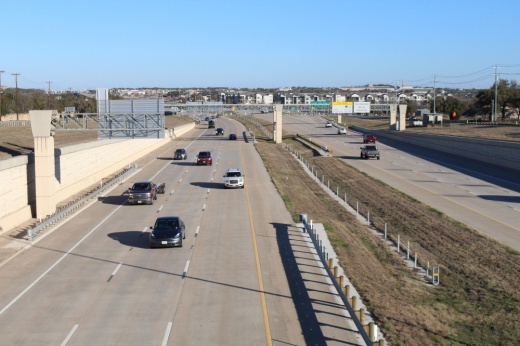The “stopping and starting” of traffic along the US 183 service road is not an option for Christianne Burke, who travels roughly an hour each way from the city of Burnet to Burnet Road in Austin for work each day.
“It’s a long commute, but if I didn’t take the toll it would be exponentially longer for me,” Burke said.
Forced to regularly navigate the Hwy. 29 traffic bottleneck and 6-mile stretch of stoplights on nontolled US 183 from Liberty Hill to Leander, Burke said she’s eager for the next phase of 183A Toll to open.
“I have a toll tag—I just consider it as part of my commute costs just like my gas,” she said.
Burke is not alone in her need to use the network of toll roads in Williamson County. Commuters across the western part of the county will soon benefit from an expansion of these toll offerings, with the Central Texas Regional Mobility Authority set to open additional 183A Toll lanes in 2025.
The newly paved roadway will extend the Mobility Authority toll lanes from the current stopping point at Hero Way in Leander up to Hwy. 29 in Liberty Hill.
Current situation
“It’s a long commute, but if I didn’t take the toll it would be exponentially longer for me,” Burke said.
Forced to regularly navigate the Hwy. 29 traffic bottleneck and 6-mile stretch of stoplights on nontolled US 183 from Liberty Hill to Leander, Burke said she’s eager for the next phase of 183A Toll to open.
“I have a toll tag—I just consider it as part of my commute costs just like my gas,” she said.
Burke is not alone in her need to use the network of toll roads in Williamson County. Commuters across the western part of the county will soon benefit from an expansion of these toll offerings, with the Central Texas Regional Mobility Authority set to open additional 183A Toll lanes in 2025.
The newly paved roadway will extend the Mobility Authority toll lanes from the current stopping point at Hero Way in Leander up to Hwy. 29 in Liberty Hill.
Current situation
The northwest region of Williamson County continues to see “unprecedented growth,” according to county officials, with projections from the Federal Highway Administration, or FHWA, indicating considerable population increases by 2040 in both Leander and Liberty Hill, 271% and 44%, respectively.
As a result, traffic volumes along the 183A Toll corridor are expected to increase by 183% over the next 25 years, according to FHWA figures.
Commuters in the area currently spend around 36 minutes on average traveling each way to work, which is 1.3 times higher than neighboring commuters in the Austin area, according to Census Bureau data.
Local transportation officials have dubbed the extension of 183A Toll lanes a “proactive congestion relief” project. The $259 million expansion, expected to open to vehicles early this year, aims to alleviate traffic and provide a more reliable transportation option.
Williamson County Commissioner Cynthia Long said this third phase of toll roads is being completed roughly seven years ahead of schedule. She explained that the “off the charts” growth in the area and regional planning done by the county has afforded the Mobility Authority means to push the project forward.
“One of the things that Williamson County has done that is unique and different from some of our neighboring counties is we have endeavored to get out in front of the traffic, rather than waiting until a roadway is failing,” Long said.
Toll roads are funded by the revenue they generate, so the Mobility Authority cannot get too far ahead of growth, Long said.
“I don’t see a whole lot of slowdown anytime soon,” she said, referring to western Williamson County. “Cedar Park, 25 years ago, was the hotbed for growth over here, and it’s just continued to arch its way up [north].”
As the tollway’s opening draws near, some residents question the potential impact the pay-for-play roadway may have on local commuters’ wallets. Tolls will cost around a dollar for each of the five fare collection points on the tollroad extension.
Those not wishing to pay toll costs are still able to use the 183 frontage roads.
“Nobody loves to pay for their roadway experience, but we pay for it anyway. We pay for it through the gas tax,” Long said. “I think we are realists in that we recognize that the gas tax is a diminishing source of revenue, and so we have to look at all options. And tolls have to be a part of the conversation.”
Regional transportation plans have included a toll alternative to US 183 since 1985, she said.
Did you know?
The Central Texas Regional Mobility Authority is an independent government agency, which was created in 2002 to improve the transportation system in Travis and Williamson counties.
Today, the agency is responsible for managing and collecting toll fares on many of the toll and express lanes in the Austin area, including 183A Toll, Hwy. 290 Toll, Hwy. 71 Toll Lane, SH 45 Toll, US 183 Toll and the MoPac Express Lanes.
The fares collected are used in the management and operation of the roadways, including things like road maintenance, administration costs, future transportation projects and debt repayments.
The 183A Phase 3 project was financed by the selling of bonds backed by toll revenue and a loan from the U.S. Department of Transportation, according to Mobility Authority spokesperson Sylvia Shelton.
The takeaway
Property values along the 183A Toll have grown by more than $1.2 billion since 2010, according to Mobility Authority data.
Local real estate metrics from Unlock MSL show the median price of homes in the area have increased nearly twofold over the last decade.
“The reason for [the corridor’s growth] is projects exactly like the 183A Phase 3 expansion,” said Bridget Brandt, president of Leander Chamber of Commerce and Visitor Center, during the toll extension groundbreaking. “Projects like this provide valuable infrastructure to our region, and it’s that infrastructure that keeps us growing.”
City documents show that Leander had 27,718 homes in 2024 and expects to add another 6,818—a 25% increase—over the next five years.
Liberty Hill also shows similar indicators of growth, with the school district’s enrollment—which nearly doubled over the past five years—expected to reach over 18,000 students in 2033.
“If you can get land in an area that’s a future growth corridor, then not only do you have a school in the right location, but you bought it at yesterday’s price, which is always beneficial to everybody,” Superintendent Steven Snell previously told Community Impact.
Chloe Young contributed to this story.
As a result, traffic volumes along the 183A Toll corridor are expected to increase by 183% over the next 25 years, according to FHWA figures.
Commuters in the area currently spend around 36 minutes on average traveling each way to work, which is 1.3 times higher than neighboring commuters in the Austin area, according to Census Bureau data.
Local transportation officials have dubbed the extension of 183A Toll lanes a “proactive congestion relief” project. The $259 million expansion, expected to open to vehicles early this year, aims to alleviate traffic and provide a more reliable transportation option.
Williamson County Commissioner Cynthia Long said this third phase of toll roads is being completed roughly seven years ahead of schedule. She explained that the “off the charts” growth in the area and regional planning done by the county has afforded the Mobility Authority means to push the project forward.
“One of the things that Williamson County has done that is unique and different from some of our neighboring counties is we have endeavored to get out in front of the traffic, rather than waiting until a roadway is failing,” Long said.
Toll roads are funded by the revenue they generate, so the Mobility Authority cannot get too far ahead of growth, Long said.
“I don’t see a whole lot of slowdown anytime soon,” she said, referring to western Williamson County. “Cedar Park, 25 years ago, was the hotbed for growth over here, and it’s just continued to arch its way up [north].”
As the tollway’s opening draws near, some residents question the potential impact the pay-for-play roadway may have on local commuters’ wallets. Tolls will cost around a dollar for each of the five fare collection points on the tollroad extension.
Those not wishing to pay toll costs are still able to use the 183 frontage roads.
“Nobody loves to pay for their roadway experience, but we pay for it anyway. We pay for it through the gas tax,” Long said. “I think we are realists in that we recognize that the gas tax is a diminishing source of revenue, and so we have to look at all options. And tolls have to be a part of the conversation.”
Regional transportation plans have included a toll alternative to US 183 since 1985, she said.
Did you know?
The Central Texas Regional Mobility Authority is an independent government agency, which was created in 2002 to improve the transportation system in Travis and Williamson counties.
Today, the agency is responsible for managing and collecting toll fares on many of the toll and express lanes in the Austin area, including 183A Toll, Hwy. 290 Toll, Hwy. 71 Toll Lane, SH 45 Toll, US 183 Toll and the MoPac Express Lanes.
The fares collected are used in the management and operation of the roadways, including things like road maintenance, administration costs, future transportation projects and debt repayments.
The 183A Phase 3 project was financed by the selling of bonds backed by toll revenue and a loan from the U.S. Department of Transportation, according to Mobility Authority spokesperson Sylvia Shelton.
The takeaway
Property values along the 183A Toll have grown by more than $1.2 billion since 2010, according to Mobility Authority data.
Local real estate metrics from Unlock MSL show the median price of homes in the area have increased nearly twofold over the last decade.
“The reason for [the corridor’s growth] is projects exactly like the 183A Phase 3 expansion,” said Bridget Brandt, president of Leander Chamber of Commerce and Visitor Center, during the toll extension groundbreaking. “Projects like this provide valuable infrastructure to our region, and it’s that infrastructure that keeps us growing.”
City documents show that Leander had 27,718 homes in 2024 and expects to add another 6,818—a 25% increase—over the next five years.
Liberty Hill also shows similar indicators of growth, with the school district’s enrollment—which nearly doubled over the past five years—expected to reach over 18,000 students in 2033.
“If you can get land in an area that’s a future growth corridor, then not only do you have a school in the right location, but you bought it at yesterday’s price, which is always beneficial to everybody,” Superintendent Steven Snell previously told Community Impact.
Chloe Young contributed to this story.





